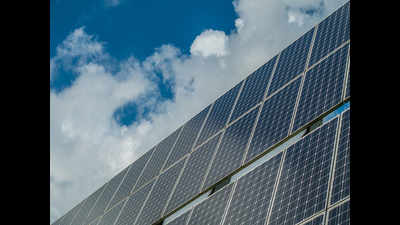- News
- City News
- shimla News
- Himachal Pradesh varsity faculty develops cost-effective sun tracking system
Trending
This story is from December 14, 2018
Himachal Pradesh varsity faculty develops cost-effective sun tracking system

Picture used for representational purpose only
SHIMLA: Faculty members of Shoolini University in Solan district have developed a cost- effective sun tracking system for individuals and small-time users. The system can keep the panel in the direction of the sun to maximize utility of solar panels.
The design patent on the proposed solar tracking system filed by Shoolini professors last year was granted on August 24. Under the circumstances, the panels come as a boon for people living in areas where power supply is a problem.“Even now, residents of rural areas in India do not have proper electricity supply. It is not economical for the government to supply electricity in certain areas owing to geological location or some other reason,” said Sorabh Aggarwal, assistant professor, School of Mechanical and Civil Engineering.
While using a small roof-top solar system can be a solution, the problem is that solar panels do not change position with the movement of the sun. Therefore, solar radiation does not reflect on the panel, which reduces its efficiency.
Many sun tracking systems are available in the market but they are too costly to be used on a small scale. Shoolini faculty members have come up with a cost-effective sun tracking system for individuals and small users, which can always keep the panel in the direction of the sun to maximize the utility of solar panels.
As concerns about depleting fuel and non-renewable sources of energy grow, solar power is being recognised as a way of minimizing dependency on fuels like coal and petroleum. The hill state has vast potential for solar power due to its clear skies. Average solar radiation level in the physiographic zones of the state is between 4 and 5.25 kwh per square metre per day, with around 300 clear, sunny days in a year. This favours commercial and domestic applications of solar energy.
Already, a 1,000 MW solar park has been proposed at Kaza in Lahaul-Spiti district. It will be developed only after a transmission line is laid for evacuation of power produced. Applications have already been invited for setting up of 250 KW to 500 KW power projects in the private sector. This will provide employment to hundreds of unemployed youth in the state.
The design patent on the proposed solar tracking system filed by Shoolini professors last year was granted on August 24. Under the circumstances, the panels come as a boon for people living in areas where power supply is a problem.“Even now, residents of rural areas in India do not have proper electricity supply. It is not economical for the government to supply electricity in certain areas owing to geological location or some other reason,” said Sorabh Aggarwal, assistant professor, School of Mechanical and Civil Engineering.
While using a small roof-top solar system can be a solution, the problem is that solar panels do not change position with the movement of the sun. Therefore, solar radiation does not reflect on the panel, which reduces its efficiency.
Many sun tracking systems are available in the market but they are too costly to be used on a small scale. Shoolini faculty members have come up with a cost-effective sun tracking system for individuals and small users, which can always keep the panel in the direction of the sun to maximize the utility of solar panels.
The design patent filed last year by Shoolini professors on the proposed solar tracking system was granted on August 24, this year. The patent was filed by Sorabh Aggarwal, assistant professor, Dr Neeraj Gandotra, associate professor, School of Mechanical and Civil Engineering and Prof Bhaskar Goel, head of the School of Mechanical and Civil Engineering. Saurabh Aggarwal said the team is working on various aspects of the project and thanked vice- chancellor Prof P K Khosla for his support.
As concerns about depleting fuel and non-renewable sources of energy grow, solar power is being recognised as a way of minimizing dependency on fuels like coal and petroleum. The hill state has vast potential for solar power due to its clear skies. Average solar radiation level in the physiographic zones of the state is between 4 and 5.25 kwh per square metre per day, with around 300 clear, sunny days in a year. This favours commercial and domestic applications of solar energy.
Already, a 1,000 MW solar park has been proposed at Kaza in Lahaul-Spiti district. It will be developed only after a transmission line is laid for evacuation of power produced. Applications have already been invited for setting up of 250 KW to 500 KW power projects in the private sector. This will provide employment to hundreds of unemployed youth in the state.
End of Article
FOLLOW US ON SOCIAL MEDIA











